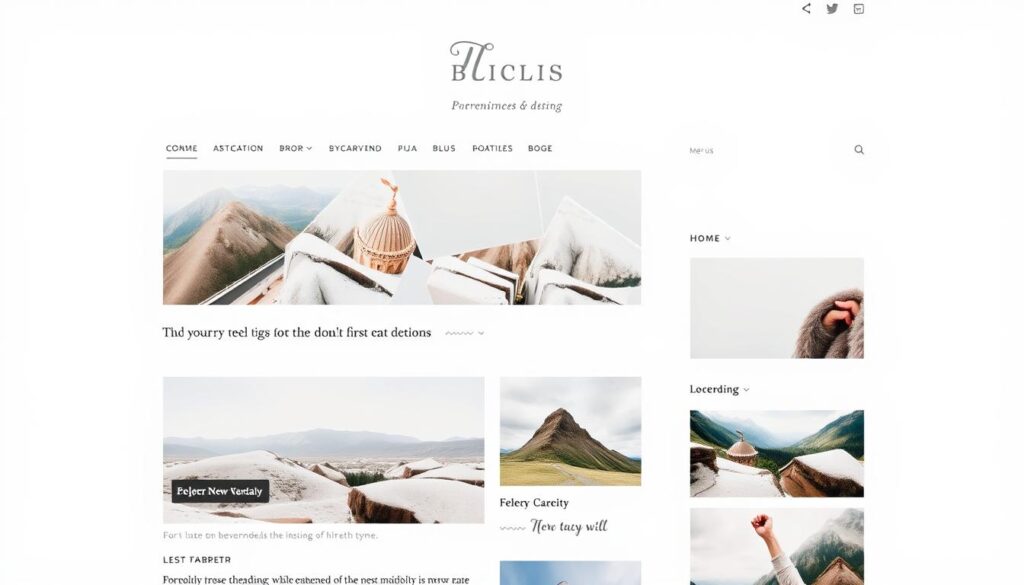Imagine you start a blog, full of enthusiasm, only to see your excitement fade in months. Many new bloggers experienced this last year. Their downfall wasn’t due to a lack of passion. Instead, they made simple mistakes, like not knowing their audience or skipping keyword research. Even Neil Patel, a top blogger, almost quit after making these beginner errors.
Blogging is more than just writing. With over 8,000 WordPress themes and Astra being used by more than 1,200,000 people, design matters a lot. It’s essential to pick the right niche, know your audience, and post regularly. Focusing on a single niche helps search engines understand and rank your content better.
Many bloggers give up after just two months. They get frustrated quickly due to unrealistic hopes. Learning SEO basics and using tools like Pinterest for marketing can make a big difference in your blog’s success. Avoiding simple errors, such as not responding to comments or using dull titles, is key.
To kick off your blog the right way, you must dodge these common errors. This guide will show you how to avoid them and start a successful blog.
Key Takeaways
- Understand your target audience and create buyer personas.
- Conduct thorough keyword research and use long-tail keywords.
- Choose a suitable blogging niche for improved SEO ranking.
- Maintain a consistent blogging schedule using a content calendar.
- Select a well-structured layout and readable fonts to enhance user experience.
- Engage with comments to build a loyal reader base.
- Leverage social media to promote your blog posts effectively.
Not Defining Your Target Audience
Starting a blog means you must know your target audience. This step helps tailor your material to the audience’s needs and interests. Shockingly, 67% of newbies skip this. They don’t think about who will read their posts. This miss can make them give up too soon.
Blogs focused on a certain group get 50% more action from readers. That’s because the content speaks directly to what interests them.
Understanding Audience Demographics
Finding out who your readers are is key. Google Analytics tells you their age, where they’re from, and what they like. Without hitting the mark on content, 72% won’t visit your blog again. So, knowing your audience’s makeup matters a lot for success.
By getting these insights, your posts can truly connect. This connection makes people more likely to stick around and engage more.
Creating Buyer Personas
To get even closer to your readers, create buyer personas. These are detailed profiles of your ideal readers based on demographics. They show their needs, aims, and what they do. Such detailed understanding can make your content way more gripping.
Content that’s tailored for these personas can pull in 18 times more profit. It’s more than making guesses about what they might like. It’s about knowing and serving them directly. This approach sets a strong base for your blog’s marketing.
Neglecting Keyword Research
Keyword research is key to understanding what your audience looks for online. It involves figuring out the words and phrases people use to find your blog’s content. Sadly, around 97% of new bloggers overlook this crucial step, harming their visibility and growth.

Ignoring keyword research means you might not reach people interested in your blog. Studies show that blogs not focusing on SEO, like keyword research, lose about 43% of their organic search traffic.
Importance of Long-Tail Keywords
Long-tail keywords are longer and more specific phrases related to what you’re posting. They may bring in less traffic each but are easier to rank for than shorter keywords. Using long-tail keywords correctly can draw more focused visitors to your blog, in line with SEO best practices.
Over 90% of shoppers look online before buying, highlighting the need for using long-tail keywords well to attract them. Blogs enhancing their content with these keywords often see up to a 30% traffic boost in three to six months.
Tools for Keyword Research
Using tools like Semrush and Ahrefs can greatly improve your keyword research. They show you not just what competitors rank for but also suggest valuable keywords you haven’t considered. These tools are excellent for finding long-tail keywords that are relevant yet not too competitive.
- Semrush: Offers detailed analysis of keyword performance and competitor strategies, assisting you in refining your SEO approach.
- Ahrefs: Provides comprehensive keyword data, including search volume and difficulty, helping you to identify the best keywords to target.
Roughly 70% of bloggers say ignoring keyword research hurt their blog’s visibility and growth. By using tools like Semrush and Ahrefs, you can focus on long-tail keywords. This strategy will make your blog more visible and engaging to readers.
Creating Topics That Only Interest You
Many bloggers make the mistake of focusing only on what they like. It’s key to write about what you love but remember your audience’s interests too. Making engaging content that matches your reader’s needs is essential. Let’s dive into how you can avoid these common pitfalls.
Conducting Market Research
To keep your content relevant, doing deep market research for blogging is crucial. This means knowing who your readers are, what they like, and what issues they face. Use tools like Google Analytics and social media to learn more about them. This helps make sure your topics are what people really want to read about.
Finding Commonly Searched Questions
Creating posts that answer common questions is another smart strategy. Use sites like AnswerThePublic and Reddit to find out what people are asking. Then, write posts that offer clear and useful answers. This builds trust and can also help your site show up more in search results.
It’s important to find the right balance between what you’re interested in and what your audience wants. With careful market research and thoughtful content planning, you’ll be able to write posts that not only draw readers in but keep them coming back for more.
Not Choosing Your Niche
Starting a blog without careful consideration of your niche is a big mistake. Choosing the right niche is key for becoming an expert and attracting loyal readers. It also cuts down on competition and lets you create content that really speaks to your audience.

- Your Skill: Use what you’re good at, whether it’s cooking or digital marketing, to make your blog stand out.
- Your Passion: Loving what you blog about will keep you going, even when it gets tough.
- Your Audience Problem: Make your blog valuable by solving your readers’ problems.
Niche marketing helps you build trust and show you’re an expert. Your audience will know what to expect, which boosts engagement and loyalty. Blogs focused on a niche tend to keep their readers around longer. With the right homepages, they can keep over 80% of their visitors.
Choosing a niche also means you can write more in-depth content. You can offer unique insights instead of just barely covering a topic. Consistent updates are crucial to keep your audience coming back. Posting once or twice a week is ideal for growing your readership.
To sum up, niche marketing should be a big part of your blog strategy. It helps you match your abilities and interests with what your readers need. This sets you up for ongoing success and recognition in your area.
Blogging Inconsistently
Inconsistent blogging can make readers confused and lower their interest. About 70% of bloggers find it hard to keep a consistent schedule. Many say a lack of clear goals, about 55%, leads to this issue.
Importance of a Content Calendar
Using a content calendar makes it easier to blog consistently. It helps you plan and stick to a regular posting schedule. This keeps your blog lively and interesting. By planning ahead, you manage your time better and keep up with posts.
Benefits of Regular Blogging
Keeping your blog updated regularly is key to keeping readers interested and improving SEO. Blogs that post often tell search engines they’re active and matter. This boosts your website in search rankings. Plus, it builds a base of loyal readers who eagerly await your updates.
Also, longer posts of at least 1,000 words are good for both readers and SEO. While new bloggers might write shorter pieces, longer ones hold reader’s attention better.
Using a Poorly Formatted Layout
Many beginners use a poorly formatted blog layout. Having a user-friendly layout helps your audience easily navigate. This improves their experience. A cluttered or hard-to-read blog drives readers away. Thus, focus on blog formatting and readable content is essential.

Readable Fonts and Short Paragraphs
Choosing readable fonts is key to keeping readers interested. Use easy-to-read fonts like Arial, Verdana, or Georgia. Stay away from fonts that are too fancy. They can distract from your message. Also, keep paragraphs short. This makes your content easier to follow.
Short paragraphs should have no more than three sentences. This style helps keep your audience engaged. It avoids overwhelming them with too much text at once.
Most online readers, about 70%, like articles with subheadings and bullet points. This organized layout keeps them on your page longer. It also helps your blog grow by attracting more leads.
Organizing Content with Headers
Using headers is key for good blog formatting. Headers like H2s and H3s help break up articles. This makes it easy for readers to scan and find what they need. For example, blogs with good images get 90% more views than those without.
Clear, descriptive headers also boost your SEO. This makes your blog easier to find online. It can keep readers on your site longer, reducing your bounce rate. By ensuring a user-friendly layout, you enhance your blog’s effectiveness and readership.
Not Linking to Other Blog Posts
A big mistake new bloggers make is not linking their posts together. By using internal links, you make a network of info that’s easy to get around. This gets readers to check out more of your site, which increases their engagement and the time they spend on it.

Internal links are key for good SEO. They let search algorithms figure out how your site is set up. They also share SEO power across your pages. For example, linking from a popular post to a new one can boost the new post’s SEO score.
Also, internal linking makes your site nicer for readers. Consider this: Sites with good internal linking get 5 times the visitors. This is because it leads readers to more useful content, keeping them on your site longer. This boosts their engagement with your content.
Think of internal linking as a core part of your content plan. It’s not just good for SEO, but it also helps show your audience more cool stuff on your blog.
Writing a Boring Introduction
The introduction is key to the rest of your blog post. It’s crucial because it prepares readers for what follows. If the intro doesn’t grab them, 80% will stop reading. This means you must catch their interest right away.

Wondering how to create a gripping introduction? Follow these steps:
- Start with a compelling fact: Did you know blogs with interesting intros get 50% more engagement? A cool fact can immediately grab your readers’ attention.
- Ask a provocative question: Like, “Ever think about why you remember some blogs but forget others?” Questions can spark curiosity.
- Begin with an anecdote: A personal story can quickly establish a connection with your audience.
An engaging intro not only captures attention but also sets the tone for your post. It’s your chance to connect and show readers they should keep reading. Use tips like these to make intros that pull readers further into your content.
First impressions are key. Creating an interesting intro is essential for keeping readers interested. It can lead to higher engagement throughout your blog.
Using Uncompelling Titles
When creating blog posts, the title is key. 80% of readers focus more on titles than the content. This makes your blog’s title the first thing to grab their attention.

Engaging titles are key to getting people to read your blog. Engaging titles can boost clicks by nearly 36%. They spark interest, promise value, and offer solutions. A strong title makes your blog stand out.
Adding power words or numbers to your title helps too. “10 Amazing Tips” or “7 Reasons Why” attract more readers. Titles that are 6-13 words long get the most traffic.
A clear, concise title grabs interest and sets the right expectations. It can keep readers around 70% more. Also, blogs help companies get 67% more leads. This shows how important a good title is for success.
To really engage your audience, spend time on your titles. Make sure they are catchy, informative, and reflect your content. A good title acts as a gateway to your blog, making it more successful.
Overloading Your Blog with Plugins
In your quest to make your blog better, you might use many plugins. These tools can improve your blog a lot. But, having too many can cause problems. For example, too many plugins, especially with high-quality images, can make your blog slow to load. If your blog takes longer to load, even by a second, you could lose 7% of your potential visitors. This shows why managing your plugins well is very important.
Maintaining optimal blog performance means exercising caution with plugin management. A blog with too many plugins can load slowly and crash often. You might also face issues where things don’t work together, locking you out of your blog’s backend. This can ruin your blog’s reputation and make your readers lose trust in you.

Too many plugins can also make your blog look messy. Complicated menus and too much information can frustrate your readers. This could make them leave your site and not come back. Plus, if you’re not careful, plugins that aren’t checked can open up security risks. This shows how bad things can get if you don’t manage your plugins properly.
People often forget about the need for backups. If there’s a problem with a plugin, you might lose important blog content. Losing content can really hurt your blog’s reliability. That’s why using only the plugins you really need and keeping them up-to-date is vital.
To wrap up, plugins are great for making your blog better when used right. Managing your plugins well can keep your blog running fast and make readers happy. Make sure to check your plugins often. This way, you keep only the essential ones and ensure a great experience for your visitors.
Ignoring Comments
Comments are a way to talk directly to your readers. They create a community feeling. They show you care about what your readers think.

Engaging with Positive Comments
Replying to positive comments makes a strong bond with your readers. Just saying “thank you” or recognizing their feedback can really help. It shows you value their thoughts and boosts interactions.
Addressing Negative Feedback Constructively
It’s important to deal with negative feedback in a helpful way. Don’t just ignore or remove a critical comment. See it as a chance to get better. Answering thoughtfully and with a wish to improve can change a critic into a supporter. These conversations tell your audience you want to keep giving them great content and are always looking to do better.
Not Using Social Media to Promote Your Post
Social media helps to spread the word about your blog. Many bloggers do not use it enough. This means they reach fewer people and have less interaction.

Scheduling Social Shares
Posting on social media regularly is key. Content marketing through social media brings in three times more leads than old marketing ways. Tools like Hootsuite or Buffer let bloggers schedule posts. This keeps content coming and followers interested.
Building a Social Media Strategy
An effective social media strategy is essential for blog promotion. It boosts your visibility by finding the right audience. Using Facebook, Twitter, and Instagram is smart. Adding pictures and interactive posts can almost double your post views and interactions.
Focusing Too Much on SEO
Having a strong SEO strategy is crucial for better visibility. But, putting too much focus on SEO can hurt other areas. It might lower the content quality and reduce how much readers engage.
Approximately 70% of American adults use Facebook for content engagement, indicating the importance of appealing, reader-centric content.
A reader-first approach matters a lot. Make your posts interesting and full of useful info to keep their value and relevance. Posting consistently, like once a week, keeps readers coming back. Blogs that post often get 68% more visitors.
Too many keywords or repeat phrases can turn readers off. They could also harm your Google ranking because of updates to Google’s algorithm. Your content should be well-structured and to the point. This boosts content quality and keeps it easy to read. Tools like Google Analytics and Google Search Console help watch over these strategies. They ensure you keep a good balance.
In the end, mixing a thoughtful SEO strategy with great content quality and putting the reader first leads to loyal followers. It also helps your blog grow in a lasting way.
Common Blogging Mistakes to Avoid as a Beginner
Starting a blog is exciting, yet full of potential pitfalls. It’s important not to skip defining who you’re writing for. You should really get to know your audience and what they want. This helps you create content that they’ll love. Many new bloggers fail to post regularly because they don’t have a plan. Picking your niche early on is crucial.
Don’t ignore the power of keywords. They can really boost your blog’s visibility. By choosing the right keywords, you could attract a lot more readers. Just remember not to overload your blog with too many plugins. Blogs that are easy to read on phones do much better. They also rank higher in search results.
Posting consistently is essential for your blog’s success. A content calendar is a great tool to keep you on track. Well-researched and engaging posts can draw in more readers. Plus, interacting with your readers and using social media can make your blog more popular. It’s said this could boost your audience by half.
But balance is key. While SEO is crucial, your content still needs to be interesting and useful. Google now favors content that genuinely helps people. Make sure your posts are not just packed with keywords but provide real value. Avoid these mistakes, follow best practices, and you’re on your way to a successful blogging journey.
Related Articles:
- Essential WordPress Plugins for a New Blog
Use these plugins to avoid common technical mistakes. - How to Secure Your WordPress Blog
Prevent mistakes that could compromise your blog’s security. - 7 Proven Ways to Increase Blog Traffic for Beginners
Avoid traffic mistakes and grow your audience effectively.








